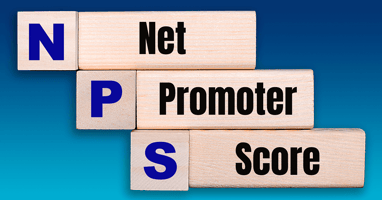The beginning of the third quarter is when many businesses roll out their mid-year Net Promoter...
Net promoter scores (NPS) are a popular method used to measure customer experience with a company’s products or services. The NPS score has become the business world’s standard metric for measuring customer satisfaction and brand loyalty. A higher NPS score means that your customers are more likely to recommend your product or services to others, making them ambassadors for your brand, but how exactly do NPS scores work?
What Are NPS Scores?
NPS is an acronym for net promoter score. Net promoter scores were invented by Bain & Company in 2003 as a metric used to determine customer satisfaction and loyalty to a company. NPS scores are gauged on a scale of -100 to +100, with a higher score being more desirable.
NPS scores are measured by asking customers the NPS question: “On a scale of 0 to 10, how likely is it that you would recommend our organization to a friend or colleague?” The numbers between 0 and 10 are used to create the three categories in the NPS scale: “Detractors,” “Passives,” and “Promoters.”
In a nutshell, companies will conduct surveys that feature the NPS question, place the respondents into different categories based on their answers, and use the data to quantify overall customer satisfaction.
How Do NPS Scores Work?
NPS scores are determined by taking your total customers and subtracting the percentage of detractors from the percentage of promoters. Scores at or above 0 are considered good NPS scores. Passives and promoters are folded together to create the overall NPS score.
The NPS Scale Explained
The NPS scale is vital because it helps companies identify which customers they need to get detailed feedback from in order to improve the overall experience. It is helpful to know what each category on the scale means in order to calculate the NPS score and create a further plan of action. Learn more about what the different scores and categories mean below:
- Detractors, or customers who scored a company between zero and six, are people who might recommend against using the product or service. A score within this category expresses general dissatisfaction toward a product or service.
- Passives are customers who rank a company or product between seven and eight. While a score like eight out of 10 might seem like high praise, research shows that customers who rate their satisfaction a seven or eight likely feel neutral.
- Promoters are the ideal customer in a company’s eyes. Promoters are customers who score the product or service a nine or a 10 and would recommend it to their friends or colleagues.
Knowing where each customer stands on the scale is crucial because it tells companies where they should seek feedback. After receiving the survey results, companies should ask themselves, “what can we do to convert detractors and passives into promoters?”
Why Are NPS Scores Important?
Net promoter scores are important because they teach companies about their customers’ experience and point them in the right direction to make improvements. NPS scores measure customer satisfaction, but more specifically they tell companies which customers are likely to be product ambassadors and which customers need a little more convincing. Moreover, surveying customers with the NPS question enables companies to dig deeper with questions like:
- What is the main reason for your score?
- How can we improve our product or service?
- What would you like to see our organization do differently?
How to Calculate NPS Scores
To calculate your company’s NPS score, you should start by sending out a survey with the NPS question on it and gathering the results. After you have collected the answers from every respondent, perform the following steps to calculate your net promoter score:
- Organize all of the responses into one spreadsheet or file
- Separate each response into one of the three categories on the NPS scale
- Add up the total number of responses in each category
- Calculate the share of each group by dividing the group total by the total number of survey responses
- Subtract the share of detractors from the share of promoters to calculate the NPS score
NPS Score Examples
Let’s say you conducted a survey utilizing the NPS question and collected 1,000 responses. Here’s how you would interpret the results:
- 200 respondents were detractors who scored your product between 0 and 6
- 100 respondents were passives in the 7 to 8 range and,
- 700 respondents were promoters or ambassadors for your brand
To calculate your NPS score based on these results, you would first find the percentages, or share, of each group.
Next, you need to subtract your detractors’ share from your promoters’ share. In this scenario, that would be 20% subtracted from 70%, which equals 50%. Since more respondents were promoters, your NPS score would be +50.
NPS scores can be negative numbers too. For example, let’s say 51% of your respondents were detractors, 4% were promoters, and 45% were passives. You would subtract 4% from 51% to get -47%, or an NPS score of -47.
Good NPS Scores
Generally, any number above zero is considered a good NPS score since we measure scores on a -100 to +100 scale. Any score that is not a negative number is usually a favorable outcome. Keep in mind that good and bad net promoter scores depend on the industry average. For example, if your competitors have NPS scores of +25, then a score of +3 is considered well below the industry average.
Bad NPS Scores
Any NPS score below zero usually equates to a negative outcome. Negative NPS scores indicate that the customer base is generally dissatisfied with the company’s products or services. If the industry average is a negative number, like -25, then having a score of -5 would be considered above industry standards in that field.
How to Improve NPS Scores
Once you have identified your company's passives and detractors and have calculated the net promoter score, it is time to create a plan of action. The focus of this plan should be to acquire additional feedback from passives and detractors to improve their overall experience. Remember, the end goal should be to convert passives and detractors into promoters and brand ambassadors. Here are a few steps you can take to improve your business’ net promoter score:
Step 1: Receive Customer Feedback From Passives and Detractors
After surveying to measure customer satisfaction using the NPS question, send a follow-up questionnaire to customers in the passive and detractor categories. Ask passives and detractors for feedback and ways to improve, it is vital for any business to receive constructive feedback from its harshest critics.
Step 2: Organize Everyone on the Team to Tackle the Issue
Once you have collected feedback from every passive and detractor, organize your team to collaborate on a plan to improve customer experience. Involve everyone on the team during the planning phase to ensure there are no blind spots when it comes to putting the plan into action.
Step 3: Conduct a Deeper Analysis to Determine Causes Among Detractors
During the planning phase, it is crucial to look at why exactly detractors would recommend against using your company’s products or services. Use this time to review the feedback and search for patterns among users. Search for common errors and issues that hinder customer experience.
Step 4: Apply the Feedback and Make Changes
After rallying your company behind you and creating a plan, it is time to put that plan into action. Make a list of actionable items and make updates to your products and services. Start out by accomplishing simple tasks first and then move on to the heavier lifts. Be sure to send out update emails and reminders to customers to let them know what improvements you are making.
Step 5: Hold Regular Meetings to Track Progress
It is unwise to think detractors will become your biggest brand ambassadors overnight. Make sure to track progress as you go along and collect feedback from your teammates. Don’t forget to continually collect feedback from detractors as well and see how they score their experience over time. Implementing an NPS program within your organization can help you collect feedback from customers and improve your brand’s overall customer experience. For more information, read our guide on how to create a successful NPS program.
How IntelliSurvey Can Help
Calculating your company’s net promoter score might be a lot of work, but it is vital in determining how customers feel about your products and services. NPS scores help measure customer satisfaction and collect feedback to improve a company’s overall customer experience. NPS scores point companies in the right direction by telling them who to collect feedback from so they can make updates accordingly.
Creating a NPS Survey
What if you don’t have a questionnaire ready-to-go to measure your detractors and promoters? They’re easy to create! Our proprietary survey software is extremely customizable, and we’re happy to help you create the experience you want. We recommend asking the following in an NPS survey:
- Demographics, if you need to know the customer’s location or similar
- The Net Promoter Score question (On a scale from 0 to 10…)
- An open response question to prompt customers to explain their primary reason for giving the numerical score for the NPS question.
- “How can we improve your experience?”
IntelliSurvey has a variety of products available to help companies conduct surveys and large multi-market studies to better understand their consumer base. If you are interested in working together, please contact us for more information.



